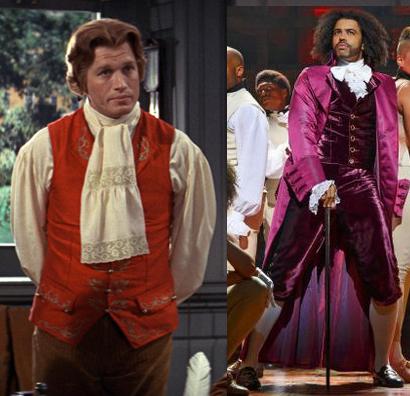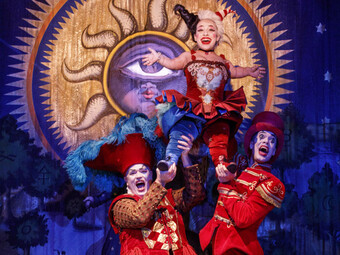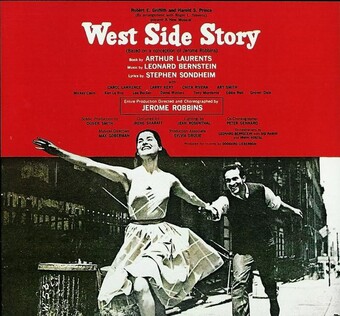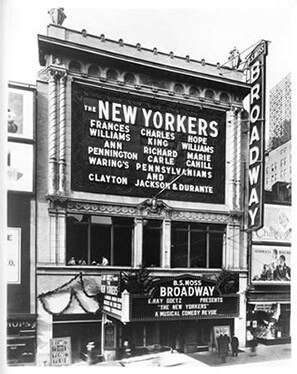Hamilton and 1776 Gave Us America, Just When We Needed It Most
Ben Franklin charmed Paris, but he couldn’t charm New York. The 1965 musical about Franklin’s adventures in eighteenth century France never found its audience and closed after six months. Hamilton, that hip-hopular retelling of America’s birth, contains no references to Ben Franklin in Paris, but it does honor a show that explored a similar world. In the middle of Act II, Alexander Hamilton yells “Sit down John!” to an unseen John Adams; any musical nut will tell you “Sit Down, John!” is the opening number to 1776.
With a book by the inimitable Peter Stone and a score by history teacher/songwriter Sherman Edwards, 1776 doubled down on the notion of putting founding fathers on stage: instead of one, they tried for all of them. Ben Franklin is joined by John Adams, Thomas Jefferson, and nineteen signers of the Declaration of Independence; even George Washington is there in spirit, as his gloomy letters are often read aloud. Built around those sweltering days that led to very first Independence Day, the show won three Tony Awards in 1969 and ran for more than 1200 performances.
In an era where everything is polarized, it's refreshing to have art that attempts to unite rather than divide. While neither show is perfect, both can be commended for asserting that America’s story is not that of the individual.
Hamilton, which continues the story almost exactly where 1776 leaves off, could not be more dissimilar in style and structure, yet both shows are spiritual cousins that reflect a stirring optimism in the story of America’s birth. “It makes even an Englishman’s heart beat a little bit faster,” wrote Clive Barnes of 1776. “Mr. Edwards and Mr. Stone have found a wonderful story for themselves in the birth pangs of a nation.” Many years later, at a fundraiser performance for the Democratic Party, President Obama said that Hamilton “reminds us of the vital, crazy, kinetic energy that’s at the heart of America—that people who have a vision and a set of ideals can transform the world.”
Every country has a creation myth, but Hamilton and 1776 take pains not to depict a pantheon of gods. Their heroes have relatable frailties, which is in keeping with the ideal that all are created equal. While both shows take liberties, they are ultimately the guardians of fact; history dictates their plot. Love letters are quoted and historical tidbits pepper the scripts. The giants of yesterday don’t always measure up today, but Hamilton and 1776 suggest that when it comes to America’s birth, the story is precisely the one we want to believe.
Both productions premiered at a time when audiences were in need of a long drink from the patriotic well. Some have already compared 2016 to 1968, when another contentious election led to protests and violence from sea to shining sea. 1776 opened at the end of a decade that had seen assassinations, race riots, and far too many deaths in Vietnam. By 1969, the counter-culture musical Hair had become a sensation by using rock and roll—not to mention drug use and nudity—to protest America’s ills. 1776, by contrast, had bi-partisan appeal—it was Nixon approved—because in focusing on the creation of the Declaration of Independence, it argued that Democrats and Republicans were united by a common ideal.
Hamilton likewise appeals to both sides. Its glory has come against the backdrop of a presidential race that saw two of history’s most controversial candidates rise to the top while a litany of tragedies dominated American and European news. Outside the theatre, populist movements on the left and the right are decrying backroom deals, echoing Aaron Burr when he pleas to be in the room where it happens:
Company: We want our leaders to save the day
Burr: But we don’t get a say in what they trade away
Company: We dream of a brand new start
Burr: But we dream in the dark, for the most part
“These couplets,” writes Miranda in Hamilton: The Revolution, “speak to something fundamentally true about contemporary politics” (190).
Both shows make a commendable effort to incorporate women into this most masculine of histories, although the compliment must come with a caveat. In both shows, women are portrayed as either the forces that support men (Abigail Adams, Martha Washington in 1776, Eliza and Angelica Schuyler in Hamilton) or obstruct them (Maria Reynolds in Hamilton). The female characters are all love objects and have no goals independent of those of their male co-stars. James McMaster has pointed out that Hamilton would fail the Bechdel Test; 1776 does as well, since its two heroines never talk to each other at all.
Despite these failings, Miranda, Stone, and Edwards deserve at least some credit for trying to remind audiences that the story of America’s birth is not entirely male-centered. Martha Washington is instrumental as Jefferson’s muse and Abigail Adams coordinates the women of Massachusetts to make saltpeter for the revolution. As for Hamilton, the women have their share of solos, most strikingly in the song Burn, in which Eliza destroys Hamilton’s letters after he publishes an account of his adultery with Maria Reynolds. In doing so, she seizes power over Hamilton’s narrative, a power she maintains in the show’s finale when she indicates she spends the next fifty years telling Hamilton’s story.

If both shows only touch on gender, race is a dominant theme in each. Early versions of Hamilton featured a rap battle in which Jefferson and Hamilton argued over slavery while in the final draft, slavery remains the unspoken elephant in the room. After the battle of Yorktown, John Laurens tells us that “black and white soldiers wonder alike if this really means freedom,” to which Washington replies, “Not yet.” Later, Jefferson enters while an ensemble of actors of color cater to his needs. “It’s the paradox of Jefferson made flesh,” wrote Miranda. “The writer who articulated liberty so clearly was an active participant in the brutal system of slavery” (152).
Miranda’s remark illustrates how Hamilton intellectualizes the problem of race in America. The decision to cast actors of color in nearly all the roles, while commendable in theory, distances us from the emotional implications of America’s past. James McMaster has argued that when a black actor re-enacts a white character’s racism, it enables “a (largely white) audience to forget the degree to which they are implicated in the violent, anti-black histories of the United States.” There is as much Brecht as there is Miranda in Hamilton, for Brecht also used epic storylines and spectacle, while breaking the fourth wall in order to make the audience think about the socio-political implications of what they were seeing on stage. Hamilton assumes its audience knows the story of American racism. It practically begs to be applauded for its decision to have the white founding fathers played by a racially diverse cast. In doing so, the show guaranteed it would have bi-partisan appeal: since Hamilton is generally considered a progressive show, being a Hamilfan makes one appear to be progressive, too.
America’s relationship with slavery is also a plot point in 1776. Independence reaches an obstacle when Jefferson tries to condemn slavery. Despite owning slaves himself, Jefferson’s original draft of the Declaration of Independence declared that King George had “waged cruel war against human nature itself.” Southern politicians objected and reminded Northerners of their thriving business building the ships that transported slaves and Southern cotton. “Who sails the ships out of Boston?” sings Edward Rutledge in the song Molasses to Rum. “Hail Africa! The slavers have come / New England, with Bibles and Rum!”
In both 1776 and Hamilton, race is an abstract idea. This is another reason why both these productions have been so successful; they address racism without actually blaming anyone for it. The enemies are indistinct and never personified in a single character. Instead of villains, both shows have sympathetic antagonists who are depicted as representing opposing viewpoints rather than an evil design. Even 1776’s slaveholders are shown to be, in the end, heroes. When Pennsylvania’s John Dickinson refuses to sign the Declaration of Independence, he is applauded by the others for standing up for his beliefs. These notions of honor and intellectual idealism are why 1776 and Hamilton ultimately sweep us into a nationalistic pitch.
In an era where everything is polarized, it's refreshing to have art that attempts to unite rather than divide. While neither show is perfect, both can be commended for asserting that America’s story is not that of the individual. Alexander Hamilton and John Adams could dream up their new nations, but they needed congresses and armies and women and immigrants to make the dream a reality. What better than a musical to assert this ideal? Every musical is the product of writers, musicians, orchestrators, designers, performers, and technicians; like America itself, they are a collaboration, the product of a multitude of minds striving for a larger goal.









Comments
The article is just the start of the conversation—we want to know what you think about this subject, too! HowlRound is a space for knowledge-sharing, and we welcome spirited, thoughtful, and on-topic dialogue. Find our full comments policy here